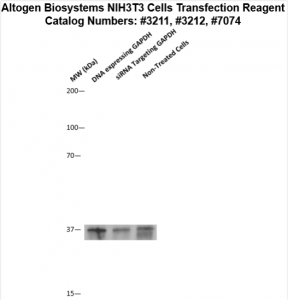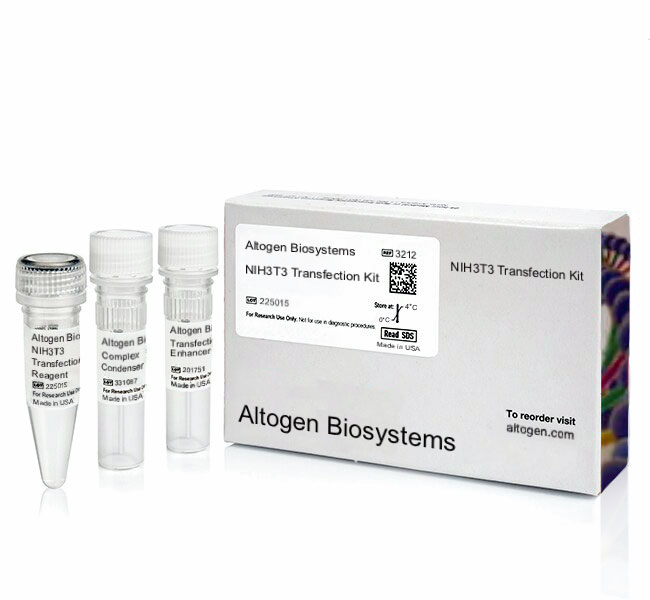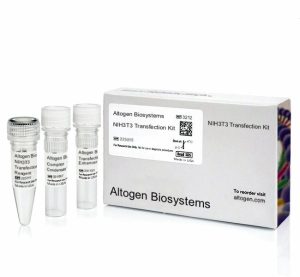Description
Purchase Orders: Click “Add to Cart” button to order, then email PO to orders@altogen.com.
Product Availability: In Stock.
Transfection Reagent for NIH3T3 Cells (Swiss Mouse Fibroblast Cells, CRL-1658)
-
Two component formulation enhances lipid mediated transfection efficiency
-
Optimized easy-to-use transfection protocol provided for transfection of siRNA, DNA, mRNA, and microRNA
-
Kit includes Transfection Enhancer reagent and recommended transfection protocol
-
High transfection efficacy in the presence of serum
-
Expand your RNAi application with a reagent optimized for delivery of both siRNA and pDNA
-
Reproducible transfection results
-
Works well for standard reverse transfection and high-throughput applications
-
Download in vitro NIH3T3 transfection protocol: [PDF]
- Download NIH3T3 CRISPR/Cas9 transfection protocol: [PDF]
-
Download PowerPoint presentation for NIH3T3 transfection kit: [PPT]
- UPC/GTIN/EAN: 860002089796
-
Brand: ALTOGEN®, developed and manufactured by Altogen Biosystems
Transfection Efficiency:
Reagent exhibits at least 85% transfection efficiency of siRNA delivery. Transfection efficiency was determined by RT-PCR.
Product Description:
Advanced formulation of NIH3T3 transfection reagent and optimized transfection protocols provide efficient intracellular delivery of proteins, DNA, mRNA, shRNA, siRNA, and other negatively charged biomolecules.
Transfection Protocol and SDS:
Download Altogen Biosystems NIH3T3 Transfection Protocol: [PDF]
Download SDS: [PDF]
NIH3T3 Cell Line:
The mouse fibroblast cell line NIH 3T3 has been extensively employed in multiple studies and is considered one of the most frequently used fibroblast cell lines. NIH3T3 are derived from a cell line of a Swiss mouse embryo established in 1962 by two scientists at the Department of Pathology in the New York University School of Medicine. 3T3 cells are characterized by their ability to grow as adherent monolayers and their high proliferative rate. These cells also have a diploid karyotype and express a variety of cell surface markers, including fibronectin and integrins.The 3T3 cell line has become the standard fibroblast cell line. Mouse embryonic fibroblasts NIH3T3 is a type of murine embryonic fibroblast cells (MEF). MEFs are often used as feeder cells in human embryonic stem cell research and for the maintenance of embryonic stem cells in the undifferentiated state. Feeder cells serve as a basal layer for other cultures and have been utilized to support the nourishment and proliferation of other cell types including stem cells. Cell layers of feeder cells cannot divide, but they secrete growth factor to the culture media, supporting the growth of target cells. MEF cell line is an excellent host for studies related to mammalian embryonic tissue, frequently employed as a transfection host in cell and molecular biology research. Many various MEF cell lines exhibit slightly different characteristics. MEF cells are also used for titration of viruses from mouse organs and tissues in lab studies. NIH3T3 cells are utilized in the cultivation of keratinocytes, with the 3T3 cells secreting growth factors favorable to keratinocytes. It has been found that NIH3T3 cells are inhibited by benzodiazepines. The 3T3 designation is an abbreviation of “3-day transfer, inoculum 3 x 10e5 cells“. NIH3T3 cells line is a good transfection host susceptible to sarcoma and leukemia viruses. Altogen Biosystems offers lipid-based transfection reagent kits for the NIH-3T3 cell line that yield high transfection efficiency, as detected by RT-PCR. NIH3T3 cells are commonly used to study cellular signaling and proliferation, including the regulation of the cell cycle, the role of oncogenes and tumor suppressor genes in cancer development, and the mechanisms of cellular transformation. This cell line has also been used to investigate the molecular mechanisms underlying drug resistance and to test the efficacy of novel anti-cancer agents. Additionally, NIH3T3 cells have been used as a platform for gene editing and genetic engineering studies.
Data:

Figure 1. GAPD mRNA levels were quantified using real-time PCR in NIH3T3 cells transfected with siRNAs targeting GAPD or non-silencing siRNA. Forty-eight hours post-transfection, the cells were harvested and analyzed by real-time PCR for GAPDH mRNA expression levels. Data were normalized against the 18S rRNA signal. Control samples were either mock-transfected or untreated. Values are normalized to untreated sample. Data are means ± SD (n=3).

Figure 2. Protein expression of GAPDH in NIH3T3 cells. DNA plasmid expressing GAPDH or siRNA targeting GAPDH were transfected into NIH3T3 cells following Altogen Biosystems transfection protocol. At 72 hours post-transfection the cells were analyzed by Western Blot for protein expression levels (normalized by total protein, 10 µg of total protein loaded per each well). Untreated cells used as a negative control.


Selected in vivo transfection product citations (ALTOGEN® IN VIVO Transfection Kits used in the following publications):
- Am J Pathology. 2010 177(4):1870-80. Role of ocular complement factor H in a murine model … Lyzogubov et al [PDF]
- Nature Biotechnology. 2011 29(4):341-5. Delivery of siRNA to the mouse brain by … Alvarez-Erviti et al [PDF]
- Cancer Research. 2011 71(15):5144-53. Inhibition of miR-193a expression by… Iliopoulos et al [PDF]
- RNA. 2010 16(11):2108-19. RNase L releases a small RNA from HCV RNA that refolds … Malathi et al [PDF]
- Diabetologia. 2012 55(7):2069-79. The p47phox- and NADPH oxidase organiser 1 … Youn et al [PDF]
- British Journal of Cancer. 2012 107(3):516-26. TIGAR induces p53-mediated cell-cycle … Madan et al [PDF]
- J Proteome Res. 2012(11) Retinal proteome analysis in a mouse model of oxygen-induced … Kim et al [PDF]
- J Transl Med. 2010 15;8:133. Prevention of hyperglycemia-induced myocardial apoptosis … Zhang et al [PDF]
- Mol Cell Biol. 2013 33(7). SCO2 induces p53-mediated apoptosis by Thr845 phosphorylation … Madan et al [PDF]
Altogen Biosystems is a life sciences company that offers cell type-specific and pre-optimized transfection products, elecroporation kits, and in vivo delivery reagents. Advanced formulation of reagents and optimized transfection protocols provide efficient intracellular delivery of protein, DNA, mRNA, shRNA and siRNA molecules. Read more about transfection technology at Altogen’s Transfection Resource. Altogen Labs provides safety and efficacy preclinical research services. GLP-compliant studies for IND applications, and drug development, including over 90 in-house validated xenograft models, safety toxicology, etc (visit AltogenLabs.com).
Volume Options:
- 0.5 ml (Catalog #3211)
- 1.5 ml (Catalog #3212)
- 1.5 ml CRISPR (Catalog #2185)
- 8.0 ml (Catalog #7074)
Purchase Orders: Click “Add to Cart” button to order, then email PO to orders@altogen.com.
Product Availability: In Stock.






